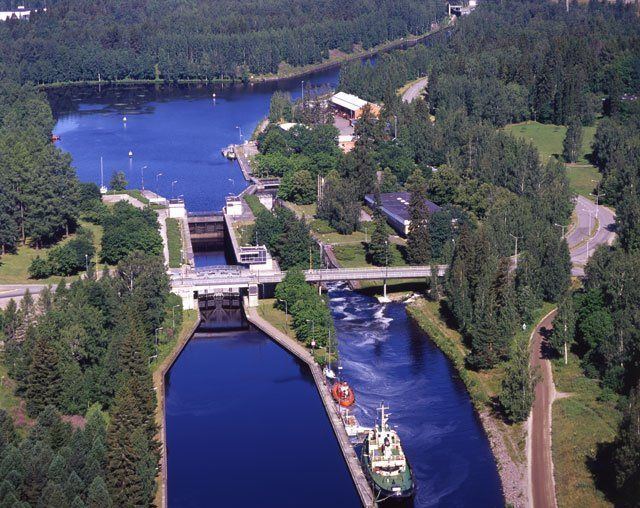 | ||
Similar Lauritsala Church, St Mary's Church of Lappee, Vyborg Castle, Mon Repos, Olavinlinna | ||
Boats in mustola lock of saimaa canal
The Saimaa Canal (Finnish: Saimaan kanava; Swedish: Saima kanal; Russian: Сайменский канал) is a transportation canal that connects lake Saimaa with the Gulf of Finland near Vyborg, Russia. The canal was built from 1845 to 1856 and opened on 7 September 1856 (Old Style: 26 August 1856). It was overhauled and widened in 1963–1968.
Contents
- Boats in mustola lock of saimaa canal
- Map of Saimaa Canal
- Flying the camera drone at the saimaa canal
- Layout
- Dimensions
- Locks
- Bridges
- History
- References
Map of Saimaa Canal
A system of inland waterways and canals in the 120 interconnected lakes of the south-central and south-east part of Finland (Finnish Lakeland) are reached through the canal. The network of deep channels in Lake Saimaa with at least a draught of 4.2 metres (14 ft) covers 814 kilometres (506 mi). The deep channels extend all the way to Kuopio in Central Finland.
Flying the camera drone at the saimaa canal
Layout
The canal begins near Lauritsala, Lappeenranta, Finland (61°04′43″N 028°16′24″E) and ends in Vyborg, Russia (60°48′38″N 028°44′13″E), connecting Lake Saimaa and the Vyborg Bay. On the way, it connects Lake Nuijamaa, on the Finnish–Russian border (60°57′6″N 28°34′33″E), and three smaller lakes in Russia.
Dimensions
Locks
There are three locks in the Finnish part of the canal
Other five locks situated on the Russian side of the border:
Mälkiä Lock has highest lift (12.4 m (41 ft)), Tsvetochnoye Lock has the lowest (5.5 m (18 ft)).
Bridges
The canal crosses
History
The canal, inaugurated in 1856, was built between the cities of Lappeenranta and Vyborg (now part of Russia), both of them then in the autonomous Grand Duchy of Finland in the Russian Empire.
In the Moscow Peace Treaty of 1940, the Karelian Isthmus and the city of Vyborg were ceded to the Soviet Union, thus effectively splitting the canal in half and ending all traffic.
Following a treaty agreement in 1963, the USSR leased the Soviet section of the canal area and the Maly Vysotsky Island (Ravansaari) to Finland for fifty years. A new deeper canal was constructed by the Finns, which opened to traffic in 1968. The length of the canal itself is 42.9 kilometres (26.7 mi). Under the new Saimaa Canal lease treaty signed by the Finnish and Russian governments in 2010, Maly Vysotsky Island was again to be managed by Russian authorities. The treaty went into effect on 17 February 2012.
The area is not part of Finland; it is a special part of Russia. Russian law is in force, with a few exceptions concerning maritime rules and the employment of canal staff, which fall under Finnish jurisdiction. There are also special rules concerning vessels traveling to Finland via the canal. Russian visas are not required for just passing through the canal, but a passport is needed and it is checked at the border.
Negotiations in 2008 agreed upon an extension of 50 years beginning in 2013, with an increase of the yearly rent of 290,000 euros to 1.22 million euros. The rent will thereafter be adjusted every 10 years. (The original rent was increased only once between 1963 and 2013.)
